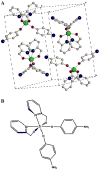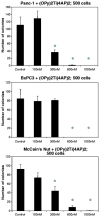Cytotoxic activity of the titanium alkoxide (OPy)(2)Ti(4AP)(2) against cancer colony forming cells
- PMID: 20820908
- PMCID: PMC3977178
- DOI: 10.1007/s10637-010-9530-3
Cytotoxic activity of the titanium alkoxide (OPy)(2)Ti(4AP)(2) against cancer colony forming cells
Abstract
A novel family of titanium alkoxides with two stable pyridinemethoxide moieties bound to a titanium metal center were synthesized and tested for cytotoxic activity on a variety of cancer cell lines using colony formation assays. One compound, (OPy)(2)Ti(4AP)(2), where OPy is NC(5)H(5)CH(2)O(-), and 4AP is 4-aminophenoxide ((-)OC(6)H(5)(NH(2))-4), demonstrated increased cytotoxicity in breast, colon, and pancreatic cancer cell lines at 100 nanomolar levels with only short exposures. Further, (OPy)(2)Ti(4AP)(2) had activity in colon and pancreatic cancer cell lines that are usually resistant to chemotherapy. This demonstrates that these titanium compounds may have a role in anti-cancer therapy, similar to platinum-based compounds, and the (OPy)(2)Ti(4AP)(2) compound specifically deserves further investigation as an anti-cancer agent in chemo-resistant solid tumors.
Figures




References
-
- Wohl D, Canetta R. Clinical development of platinum complexes in cancer therapy: an historical perspective and an update. Eur J Cancer. 1998;34:1522–1534. - PubMed
-
- Desoize B, Madoulet C. Particular aspects of platinum compounds used at present in cancer treatment. Crit Rev Oncol Hematol. 2002;42:317–325. - PubMed
-
- Kelland L. The resurgence of platinum-based cancer chemotherapy. Clin Cancer Res. 2007;13:4960–4963. - PubMed
-
- Caruso F, Rossi M. Antitumor titanium compounds. Mini Rev Med Chem. 2004;4:49–60. - PubMed
-
- Harding MM, Mokdsi G. Antitumour metallocenes: structure-activity studies and interactions with biomolecules. Curr Med Chem. 2000;7:1289–1303. - PubMed
Publication types
MeSH terms
Substances
Grants and funding
LinkOut - more resources
Full Text Sources
Medical

